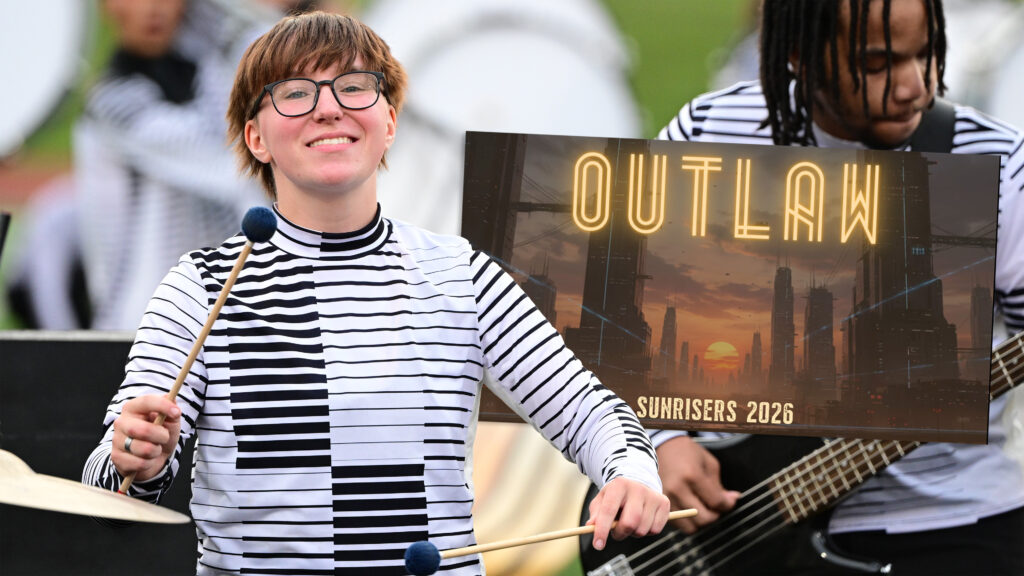The Corps with the Golden Show, part 1 Before the autumn meetings and auditions took place, the Cavaliers’ design team took stock of the previous seasons’ missteps and set out on a gameplan to not repeat these programming hiccups.
Scott Koter:
With “Frameworks” (2002), (the program was centered around) melody, harmony and rhythm. In “Four Corners” (2001), (we had) four corners, four different styles of music. We had some sort of story line and identity in the music, even though it was an original composition, to reflect the resource.

What we found in the “Spin Cycle” year (2003) was that we had a blank slate. For “Spin Cycle” we just brainstormed as many ways as we could show spinning. We didn’t have a story line. We (also) didn’t do timelines. So when Richard (Saucedo, Cavaliers’ brass arranger) would have a piece of music, we’d bring it out and get it done. It was tedious because we didn’t know what to expect, so we couldn’t conceptualize about uniforms or props or flags or types of drum equipment. We just had to wait until we got there. For the “Spin Cycle” year, I was also off my feet for about four months — I had broken my leg badly and couldn’t move, and so things fell through the cracks. So in 2004 I was just more involved. One thing we knew going into the 2004 year was that we should be maybe a little more left-brained in our approach to designing a show. We did a timeline, so therefore we knew approximately how much each production was going take (for the corps to learn). For the Christmas camp, we would have the first minute and a half (of the music completed). MP3 of the first segment of “007” Purchase the 2004 DCI Division I World Championships CD set Then (at the camp after that) we would have (much of the) the brass music (completed), with the percussion one camp behind us. By the next camp, when we were to go outside, Richard Saucedo would have the entire brass book done. By Memorial Day camp, then, the entire music book would be done. So by Memorial Day, we would play through the entire show.
As autumn progressed and the Cavaliers began preparing for the 2004 program, a few members of the Cavaliers’ design and program teams expressed some reservations about doing a James Bond-oriented program.
Jeff Fiedler:
There were some concerns initially, but most of those were more public relations and marketing-oriented, and if anyone would take us seriously when we announced it. We had made something of a game of it in the ’80s and ’90s, telling people we were doing James Bond music. Then it was an inside joke!
Andrew Toth:
I don’t think that anyone can be 100 percent about a program. There is always risk involved, especially when deciding on a program a full year in advance. Will the members, audience, alumni, and judges all enjoy it?
Jeff Fiedler:
I think because we all trust each other’s input (the design team and the tech staff are tremendous teachers), we were all excited by the music. And the concept, it opened up new possibilities and it gave the corps a strong identity.
Andrew Toth:
Everyone that was involved with the corps believed in the program and made the program itself believable.
Meanwhile, the “007” show continued to take shape.
Scott Koter:
We had this story line that we followed very strongly. I have to give credit to Rick Lunn , who produces our DVDs and is our tour manager. He’s awesome. He has so much background in film — so as a favor, going into our program meetings, I said, “Rick, would you do a character analysis and a movie analysis of James Bond?” So he did. It was like a college research project, and he analyzed it and picked it apart to the point that we knew what aspects were in every James Bond movie, why we (the public) like James Bond. (Every Bond movie) follows what you’d call the classic theater arc — it starts at the bottom up, with a small spike, then it goes up even higher, so the story line keeps rising and it keeps you intent. Rick Lunn’s James Bond character analysis At the program meeting we came up with the story line, and we knew we’d have what every James Bond movie has — a catchy tune or a unique kind of moodset. That’s either first or second, because if that’s not first, then the first thing is that he’s involved in some sort of action that may or may not be related to the story. Much of the story line of the “007” show was hammered out at Cavaliers’ program meetings in the autumn of 2003.
Scott Koter:
We decided to get the mood thing happening, where we used that “Goldeneye” reference at the beginning, and then the second thing was “Hovercraft.” The next thing, we cleansed the palette — as if he were going to a foreign country, because he always goes to exotic countries in his movies. The introduction of the “007” drill, leading into the first impact “Bond in a bubble” — where the guy was in the middle of the drum line that went through the form — we knew way back that Michael (Gaines, the Cavaliers’ drill designer) wanted to cleanse the palette, he wanted to do something like that. As far as the story line goes, we called that “Bond in the bubble” because he was in some kind of underwater apparatus going to Cuba. We went to Cuba, because in every James Bond movie there is a seduction, in this case it was a dance. The love interest was implied by a flag (because the Cavaliers are an all-male corps), so we’d have the love scene of Paris and Bond (Paris was a character in “Tomorrow Never Dies”), where the title comes from. View a video of the “Welcome to Cuba” sequence of “007” Then the closing production, with the story line we developed, was just the culminating event, where James Bond fights in a battle he eventually wins. And that’s what we did. Once we got to the gunfight, we went to the classic James Bond theme. That’s the story line we developed at our September meeting, and it held through for the whole season. The whole design process had helped us in communicating to the kids and everybody knew what it was when we talked about it. The Cavaliers’ marching members were the last to weigh in on the James Bond program. Some members expressed reservations early on.
Kyle Adelmann:
The new guys auditioning thought the idea of a James Bond show was just the coolest thing ever. I have both the drum major and the drum sergeant going to school with me (University of Illinois) and they told me (about the James Bond program) as soon as they knew. The three of us were a little nervous about the idea because it was a complete turnaround of show concepts from “Spin Cycle.”
Huei-Yuan Pan:
Honestly, I have to say I was skeptical at first. I actually heard the news fresh-off-the-press from a group of my excited private lesson students upon walking up one afternoon to the school where I teach. To describe my first impressions, I would use words like “incredulous” and even “horror-struck,” but at the same time “intrigued.” If there’s one thing I know after spending the last three summers with the Cavaliers, it’s that you trust our design team.
Pepe Ochoa:
At first, I feel everyone was kind of uneasy about it. We did not know what to expect from the design team and our staff. It gave us a hunger about what the show was going to be like. We kept wanting more and more information.
Jeff Fiedler:
Some (members) were excited, some gave it a jaundiced eye, some had reservations they kept to themselves, some were wait and see, some completely trusted the design team. Once they heard the actual cuts of what we wanted to do, they started to get excited. By the time the music was in their hands in November and December, they were sold. Honestly, most of them didn’t really care, we had another great return, moreso because of the summers we had experienced in the past and the experience they had participated and wanted to do that again, no matter what we chose.
Andrew Toth:
Since a majority of the members had only performed original programs designed specifically for them in the past, there was some slight hesitation toward having to recreate existing music and character. Once they heard the arrangements though, much of that hesitation faded.
Kyle Adelmann:
It didn’t take me long to accept it and start getting really excited about the music, especially because we have the best design team around and I knew they wouldn’t EVER let us do something cheesy.
Tomorrow we’ll look at how “007” evolved through the winter and summer of 2004
Cast of Characters:
Kyle Adelmann — 2004 Cavaliers mellophone player
Jeff Fiedler — director of the Cavaliers
Michael Gaines — Cavaliers drill designer (submitted drill PDFs)
Scott Koter — program coordinator of the Cavaliers
Rick Lunn — Cavaliers’ assistant tour manager (submitted above James Bond PDF)
Pepe Ochoa — 2004 Cavaliers guard sergeant
Huei-Yuan Pan – 2004 Cavaliers front ensemble member
Andrew Toth — Cavaliers color guard designer
Previous Recap features:
Eighty-three





